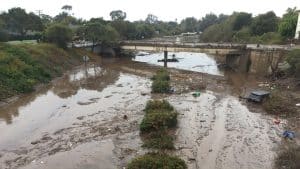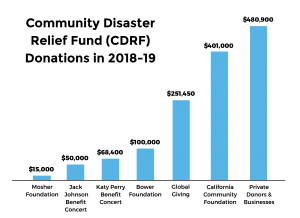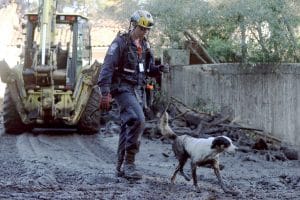BY SAM WATERSTONE

Two years after the Thomas Fire and 1/9 Debris Flow, the Santa Barbara Foundation continues to provide support to nonprofit organizations and disaster survivors.
Barbara Andersen, the Santa Barbara Foundation’s former Chief Strategy Officer and an expert in emergency management, knew that disaster would eventually strike our region. In the years prior to the aforementioned disasters, Andersen directed the Aware & Prepare Initiative, a public-private partnership led by the Orfalea Foundation, which invested in building the critical infrastructure and programs for emergency preparedness in Santa Barbara County.
As the initiative evolved over ten years, the Santa Barbara Foundation partnered with the Orfalea Foundation to create a Community Disaster Relief Fund (CDRF), to be activated in the aftermath of an emergency, to support nonprofit organizations in short-term and long-term recovery. After the 1/9 Debris Flow, the Foundation began rapidly fundraising for the CDRF through a variety of avenues including benefit concerts, private donations, and other local, statewide and national foundations.

SBF ultimately raised over $1.3 million, the majority of which has since been granted to nonprofits included in the collaboration known as the Santa Barbara County Voluntary Organizations Active in Disaster (SBC VOAD). SBC VOAD organizations have already been vetted for their commitment to preparedness and response, and have defined roles in the disaster relief and recovery processes.
One area of recovery often overlooked by philanthropy following a disaster is long-term recovery. Early on in the development of the CDRF, Foundation leadership came together to understand more of what is needed from a community foundation in the entire lifespan of regions impacted by disaster – and that the most important perspective is to hold the marathon view, and not the sprint.
“Community recovery isn’t linear, there’s no one way to solve it, no prescribed path,” explained Andersen. “It takes many forms, depending on the level of private resources, government resources, overall leadership, and the number of people that have been affected by that particular disaster.”
Representatives from the Foundation sit on the Community Long Term Recovery Group (CLTRG), a roundtable of disaster recovery organizations tasked with coordinating the long-term recovery of the community.
“A lot of the organizations around that table are VOAD organizations, because they have a role that is pre-established,” said Andersen. “But then you also have philanthropic institutions [like SBF and the United Way of Santa Barbara County] and government agencies, and the goal is to work together to make more effective and efficient decisions.”

Nearly two years after the disasters, most major funders that were instrumental in supporting the initial recovery efforts are no longer funding nonprofit organizations or individuals to specifically help with recovery. Consequently, the CLTRG has begun addressing individual survivors’ unmet needs, through a Finance Group (co-chaired by Andersen and Steve Ortiz, President & CEO of United Way of Santa Barbara County) appointed to coordinate a Disaster Case Manager who reviews cases anonymously and make funding allocations.
With coordination from the CLTRG, the Santa Barbara Foundation has granted $305,000 to the United Way for the specific purpose of funding Disaster Case Management and supporting the long-term well-being of disaster survivors and their families. Currently, the CLTRG employs Quinn Yowell, a trained Disaster Case Manager, who works with the United Way to provide direct support to disaster survivors with enduring long-term recovery needs.
Many people lost their homes to fire or debris flow. Others lost their source of income. Some lost both. For these survivors, getting back to life as they knew it pre-disaster is unlikely. But it is possible to get connected to the resources that will allow them to become self-sufficient in the future – basic things like affordable housing, furniture for their new residence, tools to re-launch their business, or access to mental health services.
“We call it the ‘new normal,’ because it’s not really going to be normal, but more like getting back to a point of stability,” described Yowell. “The most rewarding part of my job is when a client says to me, with a smile, ‘I’m finally starting to feel stable, and it’s so freeing.’”

We believe that it is the role of the community foundation to keep adapting to the needs of the community, year after year and decade after decade. And if we all work together – including foundations, nonprofits, government agencies, businesses, and residents – then we can meet survivors’ needs more quickly and effectively, and make sure nobody is left without the tools for self-sufficiency.
The Santa Barbara Foundation has facilitated two grant cycles through the Community Disaster Relief Fund. The first cycle was awarded in April 2018 to organizations taking the lead in disaster recovery – mostly VOAD organizations. The Foundation facilitated another cycle in April 2019, with funding split between organizations addressing long-term recovery, and those that are taking the lead on mitigation and preparedness for future emergencies. To learn more, visit our Community Disaster Relief Fund page.